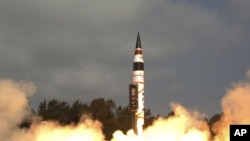India has test fired a long-range, nuclear-capable missile which can reach targets in China and Europe. The indigenously developed missile puts India in a small club of nations with intercontinental nuclear weapons capabilities.
The rocket, named Agni V, was fired a little after 8 a.m. Thursday from Wheeler Island in eastern Odisha state into its target in the southern Indian Ocean.
The head of the Defense Research and Development Organization, V.K. Saraswat, called it a successful test. He says all mission objectives have been met.
“This launch has really given a message to the entire world, that India has the capability to design, develop, build and manufacture missiles of this class,” said Saraswat.
With a range of 5,000-plus kilometers, Agni V can fire nuclear warheads anywhere in Asia and reach targets in parts of Europe.
Only a few countries - the United States, France, Russia, China and Britain - have comparable weapons.
Prime Minister Manmohan Singh congratulated the scientists who developed the rocket.
“I sincerely hope that in years to come our scientists and technologists will contribute a lot more to promoting self reliance in defense and other walks of national life,” said Singh.
A strategic analyst at the National Maritime Foundation in New Delhi, Uday Bhaskar, explains that the Agni V incorporates sophisticated technologies.
“It has a range which is 5,000 kilometers-plus. More importantly it has what is called the MIRV capability which is the ability to carry more than one warhead and being able to engage with multiple targets,” he said.
India says the missile is a deterrent because it has adopted a “no first use” policy where nuclear weapons are concerned. Agni V will have to undergo several more tests before it can be deployed by the armed forces.
The Agni V (agni meaning fire) is an advanced version of an indigenously developed series of missiles.
Strategic analysts in New Delhi say the Agni V will give India a measure of strategic parity in a region where China has emerged as a military superpower. They say there is growing concern about the military might of India’s northern neighbor.
China’s state-backed Global Times newspaper Thursday responded to the launch by saying India stands “no chance in an overall arms race with China.” The article said the two countries should develop a friendly relationship.
Uday Bhaskar says India wants to be equipped to ward off any potential threat from China.
“I think what India is seeking is a certain mutuality, which is not equivalence, but the ability to signal that its own deterrence is reasonably robust," said Bhaskar. "And that is how I would qualify the Agni test of today which is still a technology demonstrator.”
With its growing economy, India is spending billions of dollars on upgrading its military and has emerged as the world’s largest arms importer.
News
India Test Fires Long-Range Nuclear-Capable Missile





